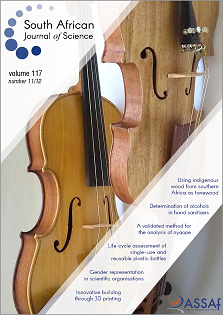An African violin – The feasibility of using indigenous wood from southern Africa as tonewood
DOI:
https://doi.org/10.17159/sajs.2021/11175Keywords:
wood for soundboards, spectral analysis, exotic wood, musical instruments, string instrumentsAbstract
The wood used to make musical instruments needs to have particular properties. Depending on its function, such as a soundboard for string instruments or the body of a wind instrument, different properties are desirable to obtain the best musical quality. Several different classification schemes exist that correlate physical and mechanical properties of wood to define desirable ranges for tonewoods, and to allow suitable wood species to be chosen. The physical and mechanical properties of various wood species indigenous to southern Africa were characterised and then assessed in terms of their suitability for violin construction using these classification schemes. The results of this analysis show that the most suitable of the wood species assessed are yellowwood and sapele. These were subsequently used by a professional luthier to build an ‘African’ violin. The sound quality of this instrument was determined subjectively through performances to an audience and more objectively via spectral analysis of audio recordings. This analysis shows clear differences in the relative magnitude of the harmonics between the violin made from indigenous wood and an instrument made with conventional wood species. Despite the differences, yellowwood and sapele were found to be suitable tonewoods, resulting in an instrument with a unique sound.
Significance:
- Good quality violins are always made from spruce and maple wood, which have to be imported to South Africa – often at high cost. However, the growth conditions of most southern African wood species should make them suitable tonewoods. We showed that several species are suitable to be used as tonewoods and that the sound produced with such a violin is – although somewhat different – of high quality.
Published
Issue
Section
License

All articles are published under a Creative Commons Attribution 4.0 International Licence
Copyright is retained by the authors. Readers are welcome to reproduce, share and adapt the content without permission provided the source is attributed.
Disclaimer: The publisher and editors accept no responsibility for statements made by the authors
How to Cite
- Abstract 1273
- PDF 730
- EPUB 241
- XML 257












.png)